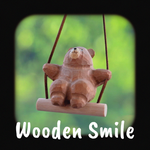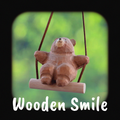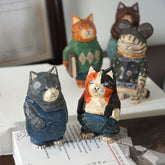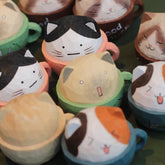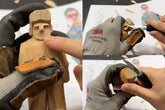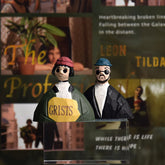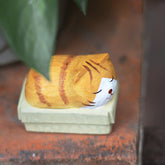Learn to Structure Wooden Gifts: Exploring Humanoid Figurine Styles
The mushroom wood figurine we shared earlier had a pretty simple structure, so drawing its design wasn’t too difficult. But when you’re working on more complex forms—like the human body—you’ll need to think more carefully about composition and structure. In this blog, we’ll walk you through how to design structure and layout when carving wooden gifts.

Sketching the figure is a crucial part of making any wooden gift. It’s the process where a woodcarver turns what they see into a plan and a creative concept. Spending some time on design before jumping into carving will not only increase your chances of success, but also save you a lot of time. Plus, it’ll help you find your own carving style much faster.

Whether you’re carving people, animals, or plants, all of them follow certain structural and motion rules. Realistic style, cartoonish style, exaggerated forms, large-scale or miniature wood figurines—they all rely on structure and movement. Once you understand these principles, your wooden gifts won’t look weird or off; the beauty will start to shine through naturally.
If you’ve ever looked at a carved character and thought, “Something just feels off,” even though the arms and legs are all there, chances are the structure is the problem. That’s why it’s essential to understand some basics of human anatomy.
No matter what carving method you use, it all comes back to the human form. You can explore different styles or ways of expression, but it still needs to be based on the human shape. Simply put, it has to resemble a person. That may sound simple, but doing it well takes a lot of effort.

Let’s look at a few examples in different styles to see how woodcarvers approach the human form. These three images show some pretty representative work.

The first figure is hyper-realistic. The second is extremely exaggerated. The third one is abstract to the extreme.
In the first image, the proportions and poses are realistic, and there’s detailed work on muscles, hair, and the folds in clothing. There are no visible carving edges or sharp planes—the surfaces are soft and blended, and the outlines are subtle. It looks like a real person, and that’s what makes it feel naturally beautiful.
The second image shows a super exaggerated figure. The head, hands, and feet are oversized, and the body is shrunken. The facial features like ears, nose, and mouth are enlarged, while the eyes are smaller. The folds in the arms and legs are simplified, but all the key details are still there. The body posture is exaggerated, but it still feels balanced and intentional. The proportions are way off from real life, but the piece still has a weird kind of beauty.
The third one is totally abstract. There’s no detail at all—just the movement of the figures. The forms rely entirely on the relationship between lines and masses to define the body’s motion. That’s where the clean, minimal beauty comes from.
Looking at these three extreme examples, we can spot a common pattern: no matter the style, the figure being carved needs to make sense within its own world. It’s not just about being realistic or getting the anatomy perfect—it’s about making sure the wood carving fits your creative intent. The key is: what are you trying to express?
The basics of the human body can actually be broken down into two parts: proportion and structure.

Things like bone length and muscle size fall under proportion—these can be adjusted and stylized. But structure is about how the joints move and their range of motion. Proportion can be exaggerated and played with; structure is rooted in biology and has to follow logic.

Proportions may seem wildly different across styles, but they usually follow a consistent visual logic within that style. Realism has its own proportions for portraying reality. American comic styles have their own too.

The logic behind stylized proportions tends to emphasize exaggeration or simplification to highlight movement and distinct traits. For example, making a figure’s head much bigger can make it look cuter. These kinds of stylized choices boost character recognition and often turn into personal artistic style. That’s why we encourage beginners to learn a bit about human anatomy—it’ll help you find your own style faster.

